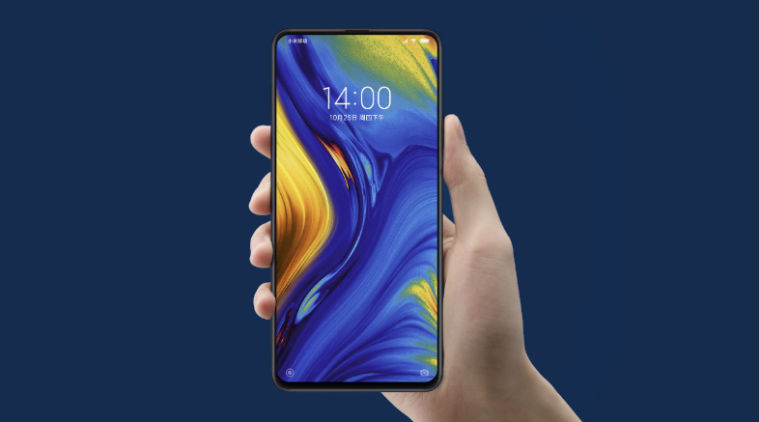 Xiaomi Mi Mix 3 offers a true edge-to-edge display with front-facing cameras slides up, making the phone completely bezel-less in nature.
Xiaomi Mi Mix 3 offers a true edge-to-edge display with front-facing cameras slides up, making the phone completely bezel-less in nature.
Chinese smartphone maker Xiaomi has been accused of blatantly copying Apple, but its latest flagship does not look like the iPhone XS. On Thursday, Xiaomi launched the Mi Mix 3 in Beijing with a true edge-to-edge display and a front-facing camera that slides up making the phone completely bezel-less in nature.
It should be clear by now that Xiaomi, the world’s fourth-largest smartphone maker by shipments, does not want to be seen as a cheap phone company, churning low-quality products. That’s important — the Mi Mix 3 also signals that the company is willing to take risks in order to challenge smartphone leaders Apple and Samsung.
The arrival of the Mi Mix 3 does tell us about the next decade of smartphones, but are people ready to pay $472 for a Xiaomi phone yet? Can the Mi Mix 3 help build a loyal fan following for Xiaomi in the high-end segment?
Slider phones are back
Xiaomi is bringing back a phone with a manual sliding form factor in 2018. Remember, Nokia N70? Even though Xiaomi isn’t the first one to launch a smartphone with the sliding design — Oppo’s Find X was the first — the Mi Mix 3 is slightly different as the phone sports a manual slider. Other smartphone vendors are also trying to implement the same sliding design mechanism. Next week, Huawei’s sister-brand Honor will release its Magic 2 with the manual slider, and Lenovo too wants to bring a similarly designed phone in the market.
So the question is why are smartphone manufacturers keen to adopt the sliding design? Well, the idea seems to be to eliminate the notch, and remove the extra bezel to create a phone that is completely edge-to-edge.
Introducing the next-generation flagship #MiMIX3, Art x Technology.
Full screen display w/magnetic slider, ultimate photo experience, ceramic body, and so much more. Coming soon. Stay tuned for more surprises! #Xiaomi pic.twitter.com/zYEDKuAyuI
— Donovan Sung (@donovansung) October 25, 2018
Also read: Xiaomi Mi Mix 3 vs Mi Mix 2: A detailed comparison of features, specifications
More RAM in phones
The Mi Mix 3 has become the world’s first mainstream smartphone with 10GB RAM. Earlier this week, Xiaomi had launched the Black Shark Helo, a dedicated gaming smartphone with 10GB RAM. While 8GB RAM on a phone is so common these days ( the list includes the likes of OnePlus 6, Asus ZenFone 5Z, Poco F1, Razer Phone 2, etc), this is the first time we are seeing a smartphone with 10GB RAM.
Do we really need a phone with 10GB RAM? Not really. For example, Apple iPhone XS Max has just 4GB RAM, but is miles ahead of the competition. Keep in mind that Apple focuses a lot on software optimisation, so a 4GB RAM is more than enough to handle heavy graphics games and multitasking. However, the same cannot be said about Google’s Android mobile OS. It has been observed that smartphones powered by Android often stutter or get frozen while playing graphics intensive games. Now, you know why Android-powered phones need more memory to process photos, run apps, and play games.
5G hype is here to stay
Earlier this week, OnePlus co-founder Carl Pei took the stage at Qualcomm’s 4G/5G summit to announce the Shenzhen-based startup will be one of the first companies to launch a 5G-ready smartphone next year. Qualcomm said it is working with 20 manufacturers on 5G products and Xiaomi is one of them.
While a 5G phone sounds brilliant, it is not exactly clear what that will bring to the user. No one seems ready to tell us the reason to buy a 5G smartphone or what problem it will solve.
Sharing one more photo. Does anyone see anything interesting? 😎#Xiaomi pic.twitter.com/LjZGibMsuR
— Donovan Sung (@donovansung) September 3, 2018
Initially, Xiaomi promised the Mi Mix 3 would be a 5G smartphone. However, we got to see a 4G smartphone and have been told to wait for a 5G variant which will hit the market in the first quarter of 2019. No other details were forthcoming. The launch of the Mi Mix 3 shows Xiaomi too wants to build the hype around the blazing fast 5G speeds and nothing else.